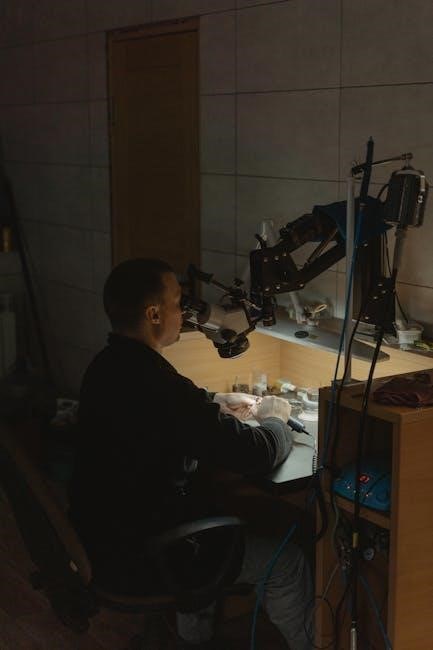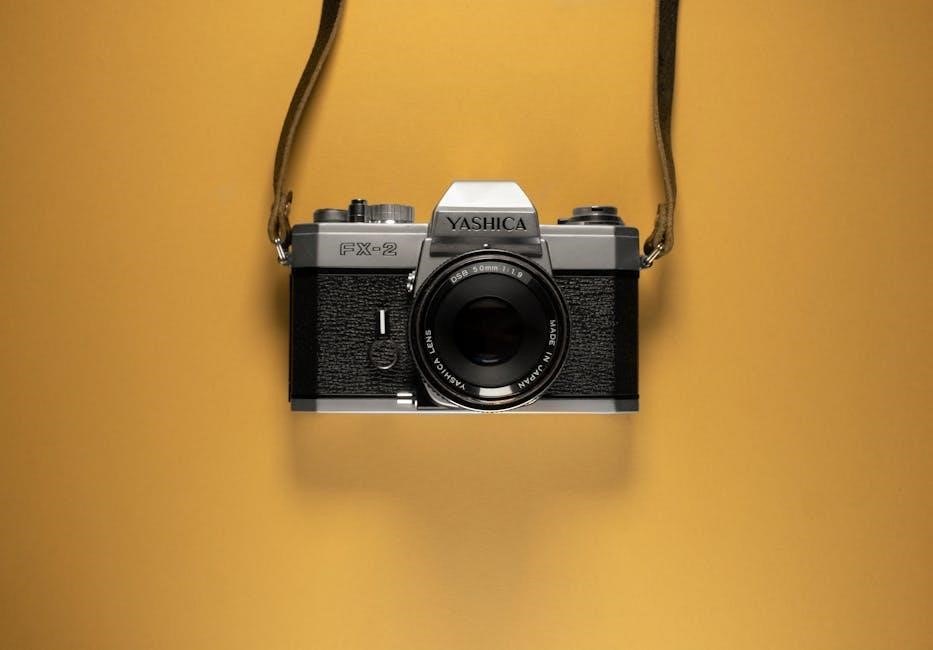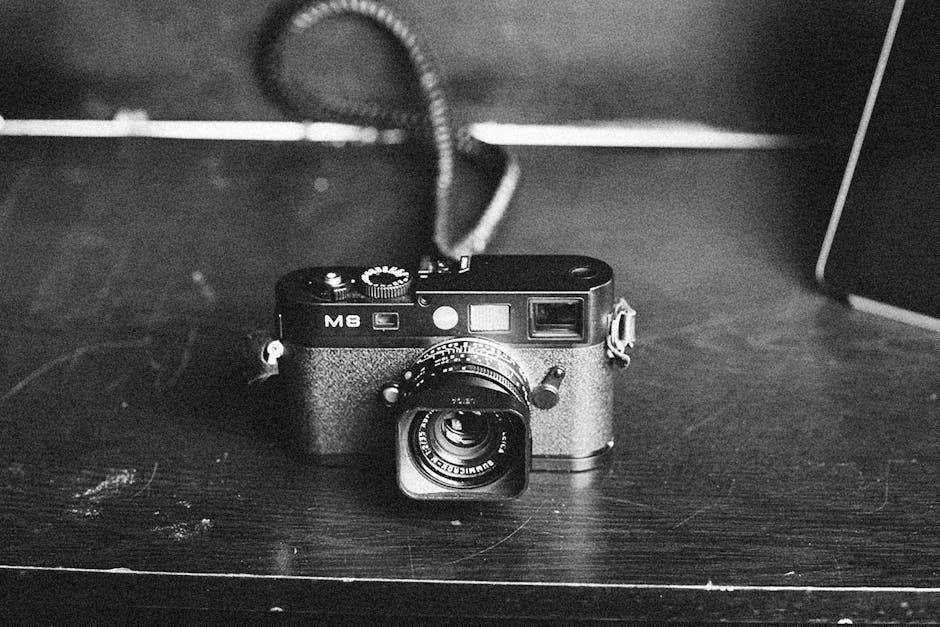The Leica DM750 microscope is a high-quality instrument designed for clinical and educational applications, offering precise optical capabilities for examining biological specimens. This manual provides essential guidance for safe and effective use.
Intended Use of the Leica DM750 Microscope
The Leica DM750 microscope is specifically designed for biological and clinical applications, offering high-quality optical performance for examining specimens. It is ideal for routine clinical tasks, such as diagnosing physiological or pathological conditions, and is widely used in medical, veterinary, and dental schools. This microscope is also suitable for research purposes, providing detailed observations and documentation of samples. The DM750 is intended to be used in controlled environments, such as laboratories or clinical settings, and must be placed on a stable, solid floor to ensure optimal functionality. It is essential to use the microscope only as described in this manual to maintain safety and effectiveness. The DM750 is a versatile tool that supports both educational and professional applications, making it a valuable asset in various scientific and medical fields.
Key Features and Benefits
The Leica DM750 microscope is equipped with advanced optical and mechanical components, ensuring high-resolution imaging and precise sample analysis. Its ergonomic design enhances user comfort during extended use, with intuitive controls for easy operation. The microscope features a robust illumination system, providing excellent brightness and contrast for clear specimen visualization. It supports a wide range of objectives and eyepieces, offering flexibility for diverse applications. The DM750 is compatible with digital cameras, enabling image capture and documentation. Its durability and resistance to environmental factors like moisture and corrosive substances make it suitable for demanding clinical and laboratory environments. These features combine to deliver reliable performance, making the Leica DM750 an ideal choice for both routine and advanced microscopy tasks in medical, veterinary, and educational settings.

Safety Regulations
The Leica DM750 microscope must be used in controlled environments, placed on stable surfaces, and protected from corrosive substances, oils, and chemicals to ensure safe operation and longevity.
General Safety Precautions
To ensure safe operation of the Leica DM750 microscope, users must follow specific guidelines. The instrument should be placed on a stable, vibration-free surface in a closed room to prevent accidental movement. Avoid exposing the microscope to damp environments, corrosive substances, or extreme temperatures, as this may damage its components. Additionally, never apply oil or grease to mechanical parts, as this can compromise their functionality. Only qualified personnel should operate the microscope, and they must thoroughly read the user manual before use. Regular inspections are recommended to ensure all safety protocols are met. Proper handling and storage are essential to maintain the microscope’s performance and longevity. Always keep the manual accessible for reference to ensure adherence to safety standards. By following these precautions, users can minimize risks and optimize the microscope’s effectiveness.
Handling and Protection Guidelines
Proper handling and protection are crucial to maintaining the Leica DM750 microscope’s performance and longevity. Avoid exposing the microscope to damp environments, vapors, acids, alkalis, or corrosive substances, as these can damage its components. Never store chemicals near the microscope to prevent accidental contamination. Additionally, refrain from using oil or grease on mechanical parts or sliding surfaces, as this can impair their function. When moving the microscope, ensure it is lifted carefully by two people to avoid structural stress. For cleaning, use only soft, dry cloths or those slightly dampened with distilled water. Avoid harsh chemicals or abrasive materials that could scratch surfaces. When transporting, secure the microscope in its original packaging to prevent damage. Store the microscope in a dry, clean environment, away from direct sunlight and extreme temperatures. Regularly inspect for signs of wear or damage to ensure optimal functionality. Proper care ensures the microscope remains a reliable tool for clinical and educational applications.

System Overview
The Leica DM750 microscope is a sophisticated optical system designed for clinical and educational use, offering advanced imaging capabilities and modular components for enhanced functionality and customization.
Components of the Leica DM750 Microscope
The Leica DM750 microscope features a robust and ergonomic design, including a high-quality optical system, a precision mechanical stage, and coaxial focus knobs for smooth operation. The microscope is equipped with interchangeable objectives and eyepieces, offering versatility for various magnification needs. The built-in illumination system provides bright and even lighting, enhancing image clarity. Additional components include a condenser for optimal light transmission and a focusing mechanism for precise specimen alignment. The microscope also supports optional accessories, such as digital cameras and polarizing modules, to expand its functionality. Durable construction ensures long-term reliability, while safety features like a built-in UV filter protect both the user and the instrument. Together, these components make the Leica DM750 a versatile and reliable tool for clinical and educational applications.
Accessories and Optional Equipment
The Leica DM750 microscope offers a range of accessories to enhance functionality and adapt to specific applications. Popular options include the Leica ICC50 W digital camera, enabling high-quality image capture and documentation. A polarizing module is available for earth sciences and materials analysis, while stage inserts accommodate different slide types, such as petri dishes or multiple slides. Additional accessories include a Bertrand lens for polarization analysis and specialized illumination systems for fluorescence or darkfield microscopy. Optional eyepieces and objectives expand magnification capabilities, while ergonomic accessories like focus knobs and stage controls improve user comfort. These optional components allow users to customize the microscope for their specific needs, ensuring versatility in clinical, educational, and research settings.

Installation and Setup
The Leica DM750 microscope requires careful unboxing and inspection. Place it on a stable, vibration-free surface in a room with consistent temperature and humidity. Connect the power supply and ensure all electrical connections are secure. Follow the manual for proper setup to ensure optimal performance.
Unboxing and Initial Inspection
Carefully unpack the Leica DM750 microscope from its shipping container and inspect for any visible damage or defects. Verify that all components, including the microscope, eyepieces, objectives, and accessories, are included and undamaged. Ensure the microscope is placed on a stable, vibration-free surface. Refer to the user manual for specific unboxing and inspection guidelines. Check for any loose or misaligned parts, and ensure all mechanical components function smoothly. Clean the microscope with a soft, dry cloth if necessary. Familiarize yourself with the manual, which contains essential safety and operational information. Complete this step before proceeding with setup or use to ensure optimal performance and longevity of the instrument. Proper initial inspection ensures a safe and effective operating experience.
Placement and Environmental Requirements
The Leica DM750 microscope must be placed on a stable, vibration-free, and level surface to ensure optimal performance. Position it in a closed room to minimize environmental interference and prevent contamination. Avoid areas exposed to direct sunlight, moisture, or extreme temperatures, as these conditions can affect the microscope’s accuracy and longevity. Maintain a consistent ambient temperature between 18°C and 25°C and relative humidity below 60% to prevent damage from condensation or corrosion. Ensure the area is free from chemicals, oils, and grease, which can damage the instrument. Additionally, the microscope should be installed away from strong magnetic fields or heavy machinery that could cause mechanical stress. Proper placement and adherence to environmental guidelines are crucial for maintaining the microscope’s functionality and ensuring precise results in clinical and research applications. Always refer to the user manual for specific recommendations tailored to your workspace.
Electrical Connections and Power Supply
The Leica DM750 microscope requires a stable power supply to operate effectively. Ensure the microscope is connected to a grounded electrical outlet, using only the provided power cord. The recommended power supply is 100-240V AC, 50/60Hz, to accommodate various international standards. Avoid using extension cords or adapters that do not meet the specified requirements, as this could lead to electrical hazards or damage to the instrument. Grounding is essential for safety and proper functionality. In case of a power outage, disconnect the microscope to prevent sudden shutdowns, which may damage internal components. Additionally, avoid overloading the power supply by connecting multiple high-power accessories simultaneously. Always follow the safety guidelines outlined in the user manual to ensure safe operation and protect the microscope from electrical damage. Proper electrical connections are critical for maintaining the microscope’s performance and longevity.

Operating the Microscope
The Leica DM750 microscope is designed for precise clinical and biological observations. Properly adjust focus, illumination, and objectives for optimal specimen viewing. Follow safety guidelines for accurate and reliable results.
Preparing the Microscope for Use
Before operating the Leica DM750 microscope, ensure it is properly prepared for use. Begin by carefully unboxing and inspecting the instrument for any damage or defects. Place the microscope on a stable, vibration-free surface in a closed room to minimize external interference. Ensure the area is free from chemicals, moisture, and direct sunlight to maintain optimal operating conditions. Connect the power supply according to the specifications in the manual, ensuring the voltage matches the microscope’s requirements. Perform a quick check of all mechanical parts, such as the focus knobs and stage movement, to ensure smooth operation. Finally, familiarize yourself with the controls and settings before proceeding with specimen preparation and observation. Proper preparation ensures accurate and reliable results during microscopy sessions.
Focusing and Adjusting the Microscope
Focusing and adjusting the Leica DM750 microscope is a critical step for achieving clear and precise images. Start by placing the prepared slide on the stage, ensuring it is securely held by the stage clips. Use the coarse focus knob to bring the specimen into approximate focus under low magnification. Once the image is roughly centered, switch to the fine focus knob for precise adjustment. Adjust the condenser to optimize illumination and contrast. Ensure the light intensity is set appropriately for the objective lens in use. If using a digital camera, focus the live image on the monitor for accurate framing. Regularly check and adjust the focus to maintain image clarity, especially when changing objectives or specimens. Proper focusing ensures optimal visualization and minimizes eye strain during extended use. Always refer to the manual for specific adjustments tailored to your application.
Adjusting Illumination and Contrast
Proper adjustment of illumination and contrast is essential for optimal imaging with the Leica DM750 microscope. Begin by ensuring the light source is set to the correct intensity using the brightness control. Adjust the condenser aperture to optimize light distribution, opening it for brighter images or closing it for higher contrast. The field diaphragm should be set to match the size of the objective lens to minimize glare and improve image clarity. For enhanced contrast, use the built-in contrast adjustment features, such as polarization or phase contrast, depending on the specimen. Always ensure the light source is evenly distributed and free from artifacts. Regularly clean the condenser and lenses to maintain optimal illumination. Properly balancing illumination and contrast ensures crisp, detailed images for accurate specimen analysis. Refer to the manual for specific settings tailored to your application.
Using Objectives and Eyepieces
The Leica DM750 microscope utilizes interchangeable objectives and eyepieces to provide versatile magnification options. Always handle objectives by the barrel, avoiding contact with the lens to prevent damage. To change objectives, rotate the nosepiece until the desired lens clicks into place. Eyepieces should be securely fitted into the eyepiece holders, ensuring proper alignment with the objectives. For optimal viewing, select objectives and eyepieces that match the desired magnification and specimen requirements. After changing objectives, adjust the focus using the coarse and fine focus knobs. Regularly clean the lenses with a soft cloth to maintain clarity. Properly aligning and maintaining the objectives and eyepieces ensures sharp, high-quality images for accurate specimen observation. Refer to the manual for specific recommendations on objective-eyepiece combinations for different applications.
Capturing Images with the Digital Camera
The Leica DM750 microscope is compatible with digital cameras, such as the Leica ICC50 W, allowing users to capture high-quality images of specimens. To begin, ensure the digital camera is properly connected to the microscope and installed with the provided software; Adjust the camera settings, such as brightness and contrast, to optimize image clarity. Use the microscope’s focus knobs to ensure the specimen is sharply defined before capturing. Once focused, use the camera’s software to preview the image and make final adjustments. Capture the image and save it to your preferred storage location. For best results, use a high-quality monitor and ensure adequate lighting conditions. Regularly clean the camera port and lenses to maintain image quality. Always refer to the camera’s user manual for specific instructions on software operation and image management. Properly capturing images enhances documentation and analysis in clinical and educational settings.

Maintenance and Care
The Leica DM750 microscope requires regular cleaning and protection from harmful substances like acids, alkalis, and oils. Store it in a dry, stable environment and perform routine inspections.
Cleaning and Routine Maintenance
Regular cleaning is essential to maintain the performance and longevity of the Leica DM750 microscope. Use a soft, dry cloth to wipe down external surfaces, avoiding harsh chemicals. For optical components, dampen lens tissue with ethanol and gently clean without touching the glass surfaces. Avoid exposing the microscope to corrosive substances, oils, or grease. Inspect mechanical parts regularly and lubricate only if necessary, following the manual’s guidelines. Store the microscope in a dry, stable environment, away from direct sunlight and chemicals. Perform routine checks on illumination systems and focus mechanisms to ensure proper function. Always refer to the user manual for detailed cleaning procedures and maintenance schedules to preserve the instrument’s precision and reliability. Regular care ensures optimal performance for clinical and educational applications.
Storage and Transportation Guidelines
Proper storage and transportation of the Leica DM750 microscope are crucial to prevent damage and ensure longevity. Store the microscope in a clean, dry environment with stable temperature and humidity levels, avoiding exposure to direct sunlight or corrosive substances. When transporting, use the original packaging or a sturdy, padded case to protect against shocks and vibrations. Avoid placing heavy objects on the microscope or its components. Ensure all accessories are securely packed separately to prevent scratching or damage. During transportation, keep the microscope upright and secure it firmly to prevent movement. Always follow the manufacturer’s guidelines for storage and transportation to maintain the instrument’s precision and functionality. Regular inspections after moving or storing can help identify any potential issues early. Proper handling ensures the microscope remains in optimal condition for future use.
Scheduled Inspections and Servicing
Regular inspections and servicing are essential to maintain the Leica DM750 microscope’s performance and longevity. Schedule inspections every 6 to 12 months or as specified in the user manual. Check for dust, debris, or damage to mechanical and optical components. Ensure all moving parts function smoothly and lubrication levels are adequate. Optical surfaces should be clean and free of scratches. If servicing is required, only authorized Leica technicians should perform adjustments or repairs to avoid voiding the warranty. Neglecting routine maintenance can lead to reduced accuracy or instrument failure. Always refer to the user manual for specific guidelines and contact Leica support for professional assistance. Regular servicing ensures optimal functionality and precision, preserving the microscope’s value for clinical and research applications.

Troubleshooting
The Leica DM750 microscope may experience issues like poor illumination or focusing problems. Check light sources, clean optics, and ensure proper sample preparation. Consult the manual or contact Leica support for assistance.
Common Issues and Solutions
The Leica DM750 microscope may encounter issues such as poor illumination, focusing difficulties, or blurry images. To address these, ensure the light source is properly adjusted and clean the optics regularly. For focusing problems, check if the stage is level and the sample is correctly prepared. Blurry images may result from dirty objectives, which should be cleaned with lens tissue. If mechanical parts malfunction, avoid using force and consult the manual or contact Leica support. Regular maintenance, such as lubricating moving parts and avoiding exposure to corrosive substances, can prevent many issues. Always follow the guidelines in the user manual to resolve problems effectively and maintain optimal performance.
The Leica DM750 microscope is a versatile and reliable instrument designed for clinical and educational applications. By adhering to the guidelines outlined in this manual, users can ensure optimal performance, safety, and longevity of the microscope. Proper maintenance, regular inspections, and adherence to safety protocols are crucial for achieving accurate results. The DM750’s advanced features and durability make it an excellent choice for both routine and specialized microscopy needs. Always refer to the user manual for detailed instructions and troubleshooting. With appropriate care and use, the Leica DM750 will remain a valuable tool for precise specimen analysis and documentation.

References
The information provided in this manual is based on the official Leica Microsystems documentation and user guides. For detailed specifications, safety protocols, and operational instructions, refer to the Leica DM750 Clinical Microscope User Manual, available for download on the Leica Microsystems website. Additional resources, such as maintenance guides and troubleshooting tips, can also be found on the same platform. Always consult the latest version of the manual for updated information and ensure compliance with all safety regulations.